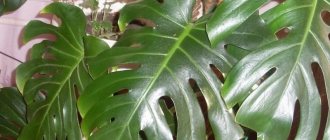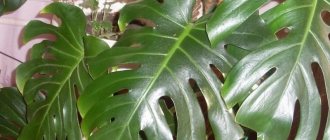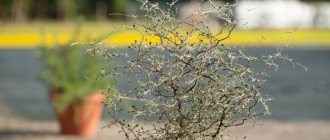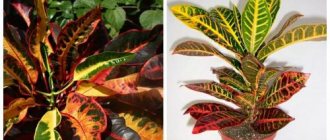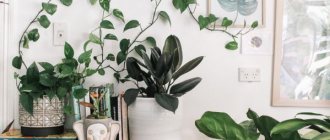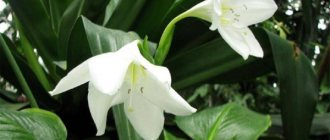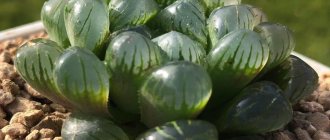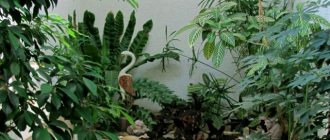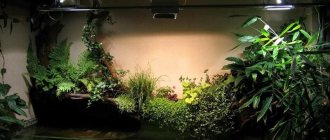Sinningia (Rechsteineria) white-haired
There are several names for the exotic plant: Sinningia white-haired, Rechsteineria (Rechsteineria) white-haired, Sinningia white-haired. Representative of the Gesneriev family. Few people can contain their delight when looking at this amazing plant. Everything about it is wonderful! The main highlight is, of course, the luxurious leaves. Silvery, velvety, iridescent leaves make Rechsteineria truly fabulous. And modest scarlet flowers only emphasize the beauty. However, in winter there is a period of dormancy and it sheds its leaves.
You can rarely find Rechsteineria on sale; the plant is quite rare. At the same time, it requires certain conditions that are difficult to comply with at home, so it is very difficult to grow it.
Indoor flowers for children
If there are small children at home, safety comes to the fore, because kids experience the world tactilely, by smell and taste. We have chosen several plants that will be completely harmless to your precious child!
Lemon Tree
Lemon is light, fresh and clean, and its leaves contain beneficial essential oils. It has a pronounced antibacterial effect, and also a subtle pleasant aroma.
Violet
Unpretentious violets create a feeling of warmth and comfort in the room, which is so valuable for children. Flowers and leaves are completely safe, because sometimes the petals are even used to decorate dishes in cooking.
Tradescantia
The flower is not only unpretentious, but also completely harmless, even if a child tastes it. Bright two-color leaves decorate the interior and delight with interesting colors.
Cypress
Children are attracted to the whimsical cypress tree by its unusual shape and texture. It has natural antiseptic properties, so it destroys bacteria and fungi around it.
Peperomia
Peperomia leaves contain healing phytoncides that improve the health of the air. This is a good choice if your child is often sick and you need to strengthen his immunity.
Decembrist
For many years, an ornamental plant with unusual segmented shoots and leaves has been found in apartments. Children are attracted by the bizarre shape and bright, colorful blooms.
Spathiphyllum
Of the unusual and flowering plants, spathiphyllum is best suited for a child's room. It also purifies the air, maintains healthy humidity in the room and does not require complex care.
Source
Ginura
Ginura is a unique indoor plant that has a fantastic appearance. Belongs to the Asteraceae (Asteraceae) family. The hairy, velvety leaves are bright purple and green. The plant should be protected from excess air and soil humidity. It is better to grow ginura on an eastern or western window. After a few years, it loses its decorative effect and needs to be replanted. The plant is poisonous, so you can only work with it with gloves!
General description of the plant
Ginura is a perennial herbaceous shrub with fluffy leaves of an unusual, bright purple color. The leaves of the plant are ovoid in shape with jagged edges up to 10 cm long. They are velvety, the top of the leaves are purple, and the lower part is dark red.
It has orange flowers that are collected in baskets and look like dandelions. Has a characteristic unpleasant odor.
Ginura has an erect and branching stem that reaches a height of one meter.
Tradescantia sillamontana
Tradescantia sillamontana is an unpretentious plant. It has very interesting leaves with gray-olive pubescence. Representative of the Commelinaceae family. In addition to the fuzzy leaves, the indoor plant is distinguished by its delicate and minimalistic flowers. It has excellent drought resistance. By the way, in the wild, the crop grows in arid areas, which is why protective fibers appeared that reduce moisture evaporation and protect from overheating. Watering should be done moderately and very carefully. Spraying Tradescantia sillamontana is strictly prohibited. Feels best on a south-facing window sill.
Episcia
An ornamental deciduous plant of the Gesneriev family is popular among plant growers due to its unpretentiousness and bright beauty of the leaves. About the latter I would like to say that they are beautiful because of their velvety surface, interesting color, pearlescent tint and veins. By the way, small flowers only emphasize the beauty of the leaves and are also worthy of attention.
It is best to place a pot of Episcia on an eastern or western windowsill because it does not tolerate direct sunlight, but without light the beauty of its leaves will fade. Soft diffused light is what you need.
Popular types of calathea: photos and names
The species differ in the appearance of leaves, patterns, and their number. You will find something to your liking.
Calathea Bachema
A species with rather lush foliage. The leaf blades are narrow, of a delicate light green hue, decorated with oblique “checkmarks”.
Calathea White Tiger or white fusion
A beautiful, unusual variety that looks like a careless sketch by a watercolor artist. An unusual combination of different shades of dark green with absolute whiteness - this flower looks like it was painted by an expressionist.
Kalathea Varshevich
The leaves are quite narrow, of a noble dark green hue, with thin, lighter veins. It blooms beautifully: the buds are white, resembling small roses.
Calathea Burle Marx
This variety differs from others in its sharper foliage: there is only one large, rounded foliage on each stem. The plate itself is a soft green shade with dark green frequent ticks.
Calathea Beauty Star
The rosette of this variety really resembles a rose of curving golden-green petals with a thick dark border around the edges and a dark green vein in the middle.
Calathea white star
A bit reminiscent of the White Tiger variety, but the leaves are larger and the rosette is more reminiscent of a star or rose. The leaves are white with thin dark green veins and edges.
Calathea vecha or vicha
This variety is distinguished by very large and beautiful leaves with an unusual pattern, reminiscent of the wings of a huge beautiful butterfly.
Calathea remarkable or lancifolia (lanceolate)
It is slightly reminiscent of aloe due to its narrow, elongated plates with a bizarre dark green on a golden green background pattern reminiscent of tiger stripes.
Calathea zebrina or striped
But this one doesn’t look very much like a zebra: a dark green plate, frequent light green veins, because of the bright contrast it feels like the foliage is glowing.
Calathea crocata or saffron
An unusual and beautiful variety with bright flowering. The flowers are bright orange, on thin, tall peduncles, and the leaves are dark green, almost black, with barely noticeable light veins. Great decoration for Halloween.
Calathea leopardina or leopardina
The foliage is quite abundant, with one leaf on a thin stem. The color is golden-green, light, with quite rare ticks of a darker shade.
Calathea litze
An unusual variety: the greenery here clearly shows a pink border, and the green itself is so dark that it seems almost black.
Calathea lubbersa
While other varieties have geometric patterns and ticks on the foliage, this large variety with large leaves has bizarre, unsystematic, and bright patterns.
Calathea makoya or makoyana
The plates are a delicate yellow-green shade with a bright pattern reminiscent of a twig with narrow dark leaves, with a dark border.
Calathea marion
A variety reminiscent of the feathers of a fairy-tale bird: rounded leaves, a light wide carved border, the core is dark green, and the leaf vein becomes lighter.
Calathea mosaic network
There are no geometric lines or ticks here - the veins here are thin and frequent, chaotic, as if millions of falling stars.
Calathea orbifolia
A variety reminiscent of the delicate leaves of water lilies: wide, rounded leaves with white-green stripes.
Calathea ornamented or ornate
Unusual variety: greens are dark to black, with graceful light stripes. An excellent decoration for a Gothic style interior.
Calathea ornata sanderina
The most popular variety of calathea is decorated.
Calathea pinstripe
The bright color of this variety resembles the skin of an exotic animal or even the comb of a dragon.
Calathea painted
Here the breeders achieved the absence of veins: the leaf is large, round, white in the middle, with a dark green border.
Calathea roseopicta
The same as the previous variety, but the middle of the plate is painted bright pink, even purple. Below are the most popular varieties of this variety.
Calathea roseopicta dotti
A variety with completely black leaves and thin pink veins in the middle and along the edge.
Calathea roseopicta illustris
Similar to the previous one, but a little lighter, not black, but dark green, but the pink border is wider.
Calathea roseopicta silvia
The plate is without veins, greenish-yellow, but the reverse is pale pink. There is a dark border along the edge.
Calathea roseopicta medallion
Representatives of this variety really resemble either a medallion in which an exotic topaz or opal is inserted, or a peacock feather.
Calathea roseopicta little princesses
An unusual variety: dark green plates with a torn pink, seemingly glowing purple border that does not reach the edge of the leaf.
Calathea rufibarba or redbeard
A variety similar to a fern, thanks to its narrow, upward shoots with ragged outlines and a light border along the edges.
Calathea silver
One of the lightest varieties with silvery-white narrow leaves and only thin, barely noticeable, dark green veins.
Calathea fasciata
The variety is distinguished by a warm, golden hue with rather rich and dark primary colors, reminiscent of the decoration of a fairy-tale castle somewhere in Italy.
Calathea flamestar
A variety with a bright, bizarre color: sharp strokes of veins in the middle and several layers of borders along the edges, because of which the plant seems to be on fire.
Calathea freddy
The variety is quite laconic compared to others, especially the previous one. Quite miniature, looks good on an office desk.
Smithianta
Smitianta is a prominent representative of the Gesneriev family. For maximum decorativeness, the plant needs bright but diffused light; a western or eastern window sill is suitable. A characteristic feature of Smithianta is a pronounced dormant period; at the end of flowering, the above-ground part dies off. During the dormant period, it is important to monitor the earthen lump; it should not dry out completely.
Top dressing when caring for gloxinias
Rapid growth of foliage and lush flowering is impossible without additional support. Gloxinia is fed alternately with organic and mineral fertilizers once every two weeks. It is best to carry out this procedure in the evening or during the day, as well as in cloudy weather, so that the sun does not damage the growth zone and foliage of the plant.
Before the buds appear, in addition to organic matter, the plant needs nitrogen, which stimulates the growth of green mass. But after the formation of buds, the release of nitrogen into the soil is limited and they switch to phosphorus-potassium fertilizers. They enhance flowering, and microelements help maintain high decorativeness of plants.
When mass flowering is completed, as part of regular care, gloxinia is fertilized twice with potassium-phosphorus in two weeks. This measure will help the tuber prepare for hibernation.
Plectranthus
Plectranthus or indoor mint is a very unpretentious, hardy and tenacious plant. In addition, indoor mint is very easily propagated by cuttings, so you can easily expand your plantation. Plectranthus has two advantages - a pleasant minty smell and velvety, carved, beautiful leaves. Under favorable conditions it can grow abundantly and quickly. Feels best in partial shade. Plectranthus belongs to the Lamiaceae family.
Pests
The main enemies of the koleria:
- scale insect;
- mealybug;
- spider mite;
- thrips.
If insects are found, you need to remove them with a sponge soaked in a solution of laundry soap and treat the plant twice with “ Aktellik ” or “Aktara” with an interval of 7 days.
Aichrizon
The second name of aichrizon is the tree of love. A small bush of the Crassulaceae family has fleshy and fleecy leaves and neat, cheerful yellow flowers. The succulent is sensitive to waterlogging, which can cause rotting of the root system. Therefore, you need to water very sparingly. Requires diffuse lighting. For the full development of the entire bush, it is recommended to periodically turn the pot.
Koleriya
Koleria has picturesque, hairy leaves and colorful, hairy flowers. A spectacular representative of the Gesneriev family. Growing koleria should not cause any special difficulties; it is unpretentious and does not require certain conditions of detention. It needs full lighting, but in summer the pot should not be in a place exposed to direct sunlight. Koleria has a pronounced dormant period - in winter the above-ground part dies off. The pot with the root system must be kept in cool conditions in winter and replanted in the spring.
Usambara violet
In nature, Uzambara violet often grows near waterfalls or mountain rivers. Has many varieties. Flowering lasts almost a year.
The leaves of the flower are round, beautifully and evenly located on the bush. The green part of the plant must be protected from sunlight, so the Uzambara violet is often placed near eastern and western windows.
The flower must be protected from drafts. It cannot be sprayed, and the need for watering is determined by the leaves. If they are elastic, it means there is enough moisture.
Columnea hairy
The ampelous plant is distinguished by long hanging shoots. At home, the columna looks very elegant and exotic. The bright red and orange fuzzy flowers are of interest. Belongs to the Gesneriev family. Requires full diffuse lighting. The soil should not be allowed to dry out, but watering should be moderate.
Columnea needs high air humidity; in this matter it is very sensitive. Without the necessary moisture, it will grow and bloom poorly. It is recommended to place the pot with the plant next to the aquariums, place the pot on a tray with expanded clay and water, and use a humidifier.
Drought-resistant indoor flowers
If you often leave, your home is always too hot, and your windows face south, you need indoor flowers that are not afraid of short-term droughts. And there are such people - we checked them all!
Zamioculcas
In common parlance, this is the same money tree that is so often found in apartments and offices. It grows quickly and looks good thanks to its elastic, shiny leaves.
Kalanchoe Blossfeld
The flower pleases not only with dark waxy leaves, but also with beautiful dense blooms, even with almost no moisture. Following the old buds, new ones immediately appear.
Sansevieria
This unusual decorative flower is reminiscent of succulents and cacti, because it also does not require complex care. Sansevieria is also called “pike tail” for its tall and elongated, erect leaves.
centipede fern
Most ferns need high humidity, but centipedes are an exception. It reproduces by elongated shoots covered with brown hairs that resemble a centipede.
Scindapsus
The amazing creeping flower is an unusual tropical visitor that tolerates dry atmospheres. He is also not afraid of overwatering, so rare but very abundant watering is enough.
Pelargonium
Of the densely flowering plants, one of the most unpretentious to dryness is pelargonium. It blooms in large inflorescences-umbrellas, which rise in lush caps above the velvety leaf plates.
indoor ivy
Unlike most climbing plants, indoor ivy does not require spraying or excess moisture. A healthy temperature regime is enough for it - and it can grow even in the far corner of the room.
